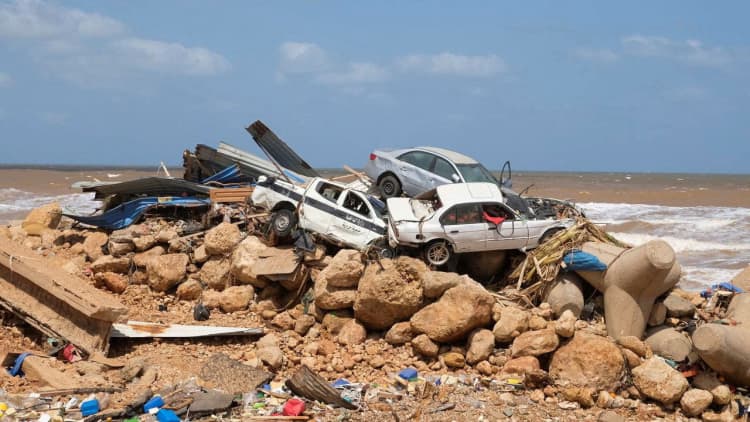At least 11,300 are now believed to have died after torrents of water ripped through eastern Libya — a devastating toll that could largely have been avoided, global officials said Thursday.
Marie el-Drese, secretary general of The Libyan Red Crescent, told The Associated Press by phone that a further 10,100 had been reported missing in the ruined city of Derna. Earlier, city officials said the death toll could reach 20,000.
A precise tally of the rising number of people killed is incredibly difficult given the level of destruction and the chaotic political situation in the region, with bodies still washing up on the shore and burials being held in mass graves.
As rescuers searched underwater and under rubble, fears grew that rotting bodies could lead to a deadly outbreak of disease in the wake of this week's floods.

Death toll could still soar
A deluge of rainfall from Mediterranean storm Daniel caused two dams to collapse, sending waves more than 20 feet high through the heart of Derna, a port city in the country's east.
More than 7,000 residents were wounded, ambulance service spokesman Osama Ali told NBC News.
Numbers have varied depending on which official has provided them, though all put the toll well into the thousands and Derna's mayor has said that it could more than triple as search teams and survivors find more bodies in the ruins.
"The situation is very large and surprising for the city of Derna. We were not able to confront it with our capabilities that preceded the storm and the torrent," Mayor Abdel Moneim al-Ghaithi told Sky News Arabia on Wednesday night.
His office said that the number of those killed could hit 20,000 — around a fifth of the city's population — based on estimates of those living in areas that were swept away.
Most of the deaths could have been avoided if authorities had better warning systems in place, the United Nations' weather and climate agency said Thursday.
"They could have issued the warnings and the emergency management forces would have been able to carry out the evacuation of the people, and we could have avoided most of the human casualties," Petteri Taalas, head of the World Meteorological Organization, told reporters in Geneva according to the AFP news agency.
The agency said this week that it issued warnings 72 hours before the dams collapsed, including contacting the Libyan authorities and making statements to the media. This led to a state of emergency being declared in the North African country.
One day before the storm hit Libya, the mayor said at a news conference that some areas surrounding the dam should be evacuated. But an emergency committee formed by the eastern government's Interior Ministry ordered curfews instead.
A spokesperson for the mayor also said out the city's dam had not been maintained since 2008 because of Libya's fractious politics.
Mohamed Manfi, president of the Presidential Council of Libya, said Thursday on X, the social network formerly known as Twitter, that the country's public prosecutor would open an investigation into any possible negligence that contributed to the disaster.
As some seek to find who to blame for the catastrophe, a humanitarian disaster is also unfolding for survivors.
More from NBC News:
Fears are rising of waterborne disease affecting the area, especially with rotting bodies still washing ashore. "Access to clean water, sanitation and hygiene facilities will be required to prevent a further crisis within a crisis," Elie Abouaoun, country director for Libya at the International Rescue Committee, said in a statement Wednesday.
Around 30,000 people from Derna are displaced, according to the International Organization for Migration, a U.N. agency.
Satellite imagery has shown the sheer scale of the destruction wrought by the floods. A government official estimated Wednesday that 25% of the city was completely destroyed or washed away.
Rescue teams from neighboring Egypt and Tunisia have arrived, alongside crews from Turkey, Italy and elsewhere.
But their efforts have been hampered by destroyed roads, as well as the interruption of power and communications in the city.
Othman Abduljaleel, the eastern Libyan government's health minister, said divers were searching seawaters off Derna.
In accordance with Islamic tradition, in which bodies are buried as soon as possible, more than 3,000 have already been placed in mass graves, he said.
The hope of finding survivors has all but faded as a colossal cleanup and recovery operation begins.
The Tripoli Public Services Company began clearing rubble in Derna's previously densely populated center Wednesday in an operation running round the clock, the state-run Libyan News Agency reported.
Its staff members are divided into three teams: one to remove rubble that may have trapped victims, one to pump out stagnant standing water and one to reopen paths by removing fallen buildings and cars swept away by the floods.
The enormous task of providing immediate aid and then rebuilding Derna is complicated by the legacies of a decade of civil conflict, which has left two rival governments ruling eastern and western Libya.
Derna is controlled by the Libyan National Army, run by Field Marshal Khalifa Hifter and based in the eastern city of Tobruk. The rest of the country is run by the Government of National Unity based in the capital, Tripoli, in the west.
This split has hampered reconstructions efforts for years — though aid workers say both sides are now talking to each other.
"Both governments have reached out to the international community requesting services and help," Tauhid Pasha, of the International Organization for Migration, told BBC Radio on Wednesday night.
"The Government of National Unity has extended its support to us and its request on behalf of the entire country and they are also coordinating with the government in the east," he said.

